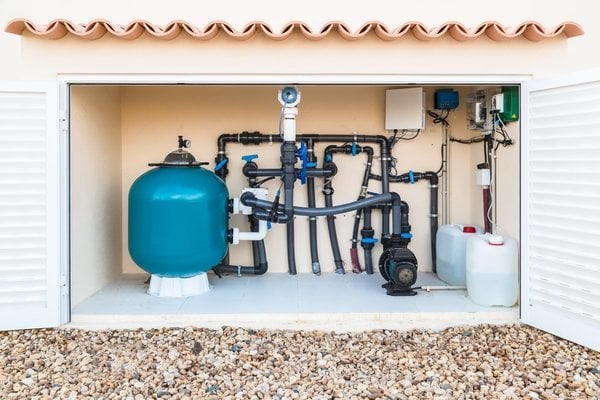
How A Pool Pump and Filter Works to Keep Your Pool Clean
When you think about a clean, sparkling pool, it’s easy to picture chlorine and skimmers — but the real hero is the unsung duo working behind the scenes: your pool pump and filter. This system is what keeps your water moving, filtered, and safe for swimming day after day.
Whether you’re a new pool owner or just curious about what’s going on in your equipment pad, this post breaks down exactly how the pump and filter work together to keep your pool crystal clear.
Why Circulation Matters
Water that doesn’t move becomes a breeding ground for algae, bacteria, and debris. That’s why circulation is the foundation of any clean pool. Your pump and filter system keeps water flowing through the pool, pulling it in, cleaning it, and pushing it back out — like a pool’s respiratory system.
Without good circulation, even the strongest chemicals can’t protect your pool from getting cloudy or green.
Step 1: The Pool Pump — Moving Water
The pump is the heart of the system. It pulls water from your pool through a series of intake points — usually the skimmers and main drain — and sends it through the filter before returning it via the return jets.
- Skimmers: Pull in surface water and floating debris like leaves, bugs, and sunscreen film.
- Main drain: Draws water from the bottom of the pool where heavier debris settles.
- Pump basket: Captures larger debris before it enters the filter, protecting the system.
The pump uses an electric motor to spin an impeller, creating suction that moves water through the system. Most pools run the pump for 8–12 hours a day, depending on the size and season.
Step 2: The Pool Filter — Cleaning the Water
Once water has been pulled in by the pump, it passes through the pool filter — which removes dirt, debris, and tiny particles that can cloud your water or clog your plumbing. There are three main types of pool filters:
1. Sand Filters
Water is pushed through a tank filled with specially graded sand that traps dirt and particles. Clean water flows out the bottom and returns to the pool.
- Pros: Low maintenance, cost-effective
- Cons: Requires backwashing and is less precise than other options
2. Cartridge Filters
These use replaceable fabric cartridges to trap debris. They don’t require backwashing — just remove, rinse, and reinstall.
- Pros: Easy to clean, captures finer particles than sand
- Cons: Cartridges wear out and need replacing every 1–2 seasons
3. DE (Diatomaceous Earth) Filters
These filters use a powder made from fossilized algae to coat internal grids. They can trap incredibly fine particles — down to 2–5 microns.
- Pros: Most thorough filtration
- Cons: More expensive, requires handling DE powder, and regular cleaning
Regardless of type, your filter’s job is to catch what your skimmer and pump basket miss — from sand and silt to body oils and bacteria.
Step 3: Water Returns to the Pool
After filtration, the now-clean water returns to the pool through return jets, often strategically placed to help circulate water throughout all areas of the pool.
- Some systems also include heaters, chlorinators, or salt cells after the filter — all part of your complete circulation loop.
- Water features like fountains or deck jets may also connect to this return line.
This cycle repeats over and over while your pump is running, ensuring your pool stays clean, balanced, and ready to dive in.
How Long Should You Run Your Pump?
A good rule of thumb is to run your pump long enough to circulate all the water in your pool once per day. This usually means 8 to 12 hours, depending on pool size and climate. You can split this time into two cycles (morning and evening) for energy savings and more even circulation.
If you have a variable-speed pump, you can run it at lower speeds for longer periods, which is more efficient and quieter.
Signs Your System Isn’t Working Properly
- Cloudy or green water
- Low pressure on the filter gauge
- Unusual noises from the pump
- Poor surface movement or dead spots
If your pump or filter isn’t performing, it could be clogged, air-locked, or in need of repair. Don’t ignore early warning signs — they can lead to bigger (and more expensive) issues later.
Final Thoughts
Your pool’s pump and filter system is its lifeline — silently working to keep your water clean, safe, and swimmable. Understanding how it works helps you care for your pool better, detect problems sooner, and enjoy crystal-clear water all season long.
